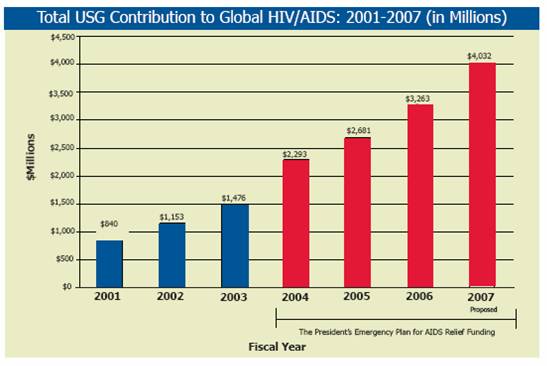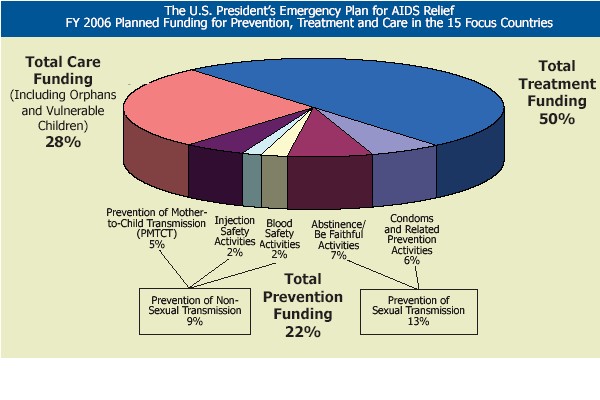Making a Difference: Funding (June 2006) PDF version PDF version
"The United States Congress and the American people have been generous in this effort, and Americans can know that their generosity is making a significant difference." -- President George W. Bush
World AIDS Day, December 1, 2005
Making a Difference: FundingThe United States leads the world in its financial support to the fight against HIV/AIDS. Through the U.S. President’s Emergency Plan for AIDS Relief (PEPFAR/Emergency Plan), the United States has undertaken the largest international health initiative in history directed at a single disease and is working in over 120 countries worldwide.
How much has U.S. funding increased since the 2001 High-Level UN Meeting on HIV/AIDS?
- In fiscal year 2001, the United States Government’s total contribution to global HIV/AIDS was $840 million.
- In 2003, President Bush announced the five-year, $15-billion Emergency Plan. The United States is on track to fulfill this commitment.
- U.S. global AIDS spending has risen from $2.4 billion in fiscal year 2004 to $2.8 billion in fiscal year 2005 to $3.2 billion in fiscal year 2006. For fiscal year 2007, President Bush has requested over $4 billion.
The historic action and bold leadership demonstrated by the United States is a quantum leap in the response against HIV/AIDS.

Where does the money go?
In partnership with host nations, PEPFAR is implementing the most diverse prevention, treatment, and care strategy in the world. Over 80% of Emergency Plan partners are indigenous organizations.
In fiscal year 2006,
- The U.S. Government plans to commit approximately $389 million to support prevention in the 15 focus countries.
- The U.S. Government plans to commit approximately $868 million to support antiretroviral treatment in the 15 focus countries.
- The U.S. Government plans to commit approximately $481 million to support care in the 15 focus countries for: orphans and vulnerable children; people living with HIV/AIDS; and counseling and testing in settings other than prevention of mother-to-child transmission.
The United States is the largest contributor to the Global Fund to Fight AIDS, Tuberculosis, and Malaria.
- President Bush pledged to contribute $1 billion over five years to the Global Fund beginning in 2004.
- By the end of 2006, the U.S. will already have exceeded President Bush’s initial pledge, bringing the U.S. aggregate contribution to the Fund to over $2 billion

President George W. Bush’s Emergency Plan for AIDS Relief is the largest commitment ever by any nation for an international health initiative dedicated to a single disease--a five-year, $15 billion, multifaceted approach to combating the disease in more than 120 countries around the world.
U.S. Department of State
U.S. Agency for International Development
U.S. Department of Defense
U.S. Department of Commerce
U.S. Department of Labor
U.S. Department of Health and Human Services
Peace Corps
For more information about PEPFAR, please visit www.PEPFAR.gov
| 
 PDF version
PDF version 